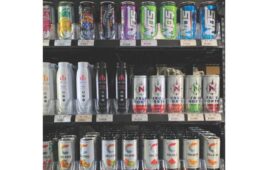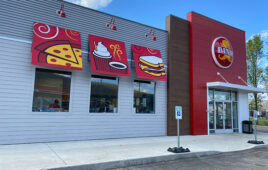Too many consumers still think Famima is a Japanese specialty foods marketer, admitted Hidenari Sato, executive vice president of the Los Angeles-based convenience store chain. However, while Famima stores are attracting more and more new customers every day to correct this misperception, the fact that Famima has a notoriously great sushi program is a tremendous asset as well.
In other words, sushi sales are strong right now, real strong. And that’s just fine by some.
“This direction of eating sushi will keep on expanding, which will allow us to introduce our convenience concept to a new consumer base,” Sato said. “Many non-Asians are trying sushi at our stores—between 20% to 30% of customers are Asian Americans, and 10% of our customers are foreigners.”
All of which puts Famima’s upscale convenience concept right on target for the top-three market drivers identified in a recent report from Technomic: Exceptional flavor and spice profiles, high-quality ingredients and regional ethnic cuisines.
The study, which found that fast-casual restaurants are growing and threatening to take over the lion’s share of foodservice sales, said consumers’ needs for dynamic variety, upscale dishes and affordability could benefit the convenience store channel as well. Twenty percent of sales surveyed were for Mexican food, 18% were for Italian, (mostly pizza) and 12% were for Asian cuisine.
Ethnic cuisine lends itself especially well to grab-and-go sales, which Technomic expects will generate about $25 billion in U.S. sales annually, as well as to prepared meals, which many c-stores use to expand food offerings.
Food Competition Not Slowing
“Competition is getting tougher,” said Technomic Vice President of Information Services Darren Tristano.
In order to continue competing successfully, Tristano said, food retailers must align themselves with the needs of their target customers.
The take-home message for c-stores: While people are eating at fast-casual establishments more frequently, convenience stores are well-positioned to benefit from steps consumers are taking in these economically troubled times, such as downsizing the eating-out portion of their budgets.
C-stores also benefit from consumers’ scaled-down driving, which is being triggered by higher gas prices. Since most customers fuel their cars at gas stations with c-stores, there’s a growing tendency to shop where they already are rather than drive across town to another food outlet, the study noted. However, Technomic found that consumers tend to think more about buying snacks and lunch at c-stores than they do dinners.
C-store food sales will continue to grow at a rate of 5.3% for stores that sell gas and 2.1% for those that don’t, but market share will remain flat, according to Willard Bishop’s “Future of Food Retailing” report. Bishop said c-store owners can take advantage of consumers’ current tendency to “trade down” on prepared food by openly comparing their food prices to those of fast-casual and fast-food chains.
Though c-store retailers provide only about 13% of the nation’s prepared meals and snacks, research from the NPD Group showed that food traffic is growing at a faster rate at c-stores than it is at restaurants—and the number of ethnic customers is growing right along with it.
Moreover, ethnic foods are drawing more consumers from groups outside the ethnicity. For example, when Wisconsin’s Open Pantry markets wanted to add more food choices for customers, Vice President Jim Schutz said the chain opted to go with a burrito bar, despite the area’s relatively low Hispanic population.
“We were a little anxious at first about how customers would respond, but our food sales absolutely skyrocketed,” Schutz said. “We knew when we went into the burrito bar we wanted to follow a healthful-with-high-flavor concept.”
The company’s first burrito bar opened three years ago and immediately took off. “Authentic Mexican cuisine is much lower in fat than most North Americans realize,” Schutz said. “We had the usual ground beef burritos available for customers, but when customers see grilled chicken and steak strips half an inch by two inches long and cubed pork loin, that’s what they want.”
As it remodels its stores, the company plans to add burrito bars at sites that have the required 400 to 700 square feet of space.
Shift to Mexican Foods Healthful
Signature Convenience Stores, a 29-unit chain based in Austin, Texas, began shifting its food program from fried foods to more healthful fare, adding 16 different varieties of breakfast and lunch tacos, including chorizo and egg. The company said its Hispanic and blue-collar consumers love the variety, especially since taco flavors are rotated so customers don’t become bored seeing the same old choices day after day. A daily average of 300 foodservice transactions at each Signature store shows the chain made the right decision.
A joint study from Packaged Facts and the Center for Culinary Development (CCD) found the predominant trend for hand-held snack applies to ethnic foods as well.
Demand grows for asian Fare
One of the most popular snacks now available in c-stores that carry them is the Chinese steamed bun, or bao, a chewy dough ball with a lightly spiced meat center.
Although traditionally filled with pork belly meat, these snacks are hugely versatile, and manufacturers are now looking to a range of different fillings such as pork shoulder, chicken and even kimchee, a traditional Korean vegetable dish, Sato said.
Other popular snack foods that hit this trend include tortas, traditional Mexican sandwiches, and empanadas, Latin American pastries.
A third study—this one from Mintel—found that while many ethnic categories were declining in demand, Chinese, Italian and Mexican categories continue to grow. The study showed nearly 50% of American consumers usually limit their ethnic-food choices to these three types.
Interestingly, the report revealed that consumers are attracted to the unusual shapes and portability commonly found in ethnic food offerings, as well as the unique tastes.
“The ethnic snack sector offers some healthy and low-fat treats and attracts both Hispanic and mainstream consumers,” CCD CEO Kimberly Egan said. “This demand is being spurred by demographic diversity in the U.S., with Hispanic and Asian populations at the top.”
Consumers—especially those in smaller, adult-only households—are willing to pay more for products that have better ingredients, more sophisticated flavors or more authenticity.
Demand for Chinese frozen cuisine in partciular is currently expected to outperform traditional American frozen-food categories, Egan said.




